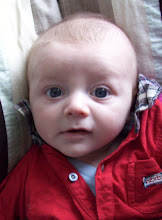Deldon's dad sent us this story to go in their mission monthly newsletter. I find it so exciting to think that the blood of this shoemaker flows in the viens of my husband and children. I love that they come from long tradition of faithful members of the Church that I've never had as my parents where the first generation for my family. Hopefully we can all do a little better, I know I can, in our efforts to take more opportunities to share what we have.
Soon after her arrival in Trondhjem, Norway, Anna Widtsoe rented an apartment for herself and her two boys in Steensbakken (Steens Hill). She was kept busy enough with household cares, dressmaking, and reading and studying her Bible. . .
One day she asked a neighbor to recommend a shoemaker to whom she might take her son’s shoes for repair. One Olaus Johnsen, a very competent, honest workman was recommended. In fact the shoemaker’s son, Arnt brought to the house a pair of captain’s shoes, and took with him for repair, a pair of John Widtsoe’s shoes. When the boy’s shoes were returned, a Mormon tract was stuffed in each shoe. A little later with a parcel containing another pair of old shoes, the widow set forth in the warm sunshine of the spring of 1879 for the half-hour walk to Johnsen’s shoemaker shop. It certainly did not occur to her that she was making the most fateful visit of her life . . .
Olaus Johnsen was a wholesome, well-spoken man in his forties; as a workman who knew his craft but who had earlier been expelled from the island of Ytteroy by the priest, owner of land he worked and the constable because he would not renounce his new found faith and moved his family of 6 via ship 47 kilometers to Trondheim. Anna Widtsoe first met Karen, and made inquiry about the meaning of the tracts found in her son’s shoes that had been returned, repaired. Mrs. Johnsen declared that they told the truth, but that Mr. Johnsen would explain the whole matter.
The shoemaker agreed to put soles on the shoes. The widow was about to leave the shop, yet a little curious about the tracts which she had found in the first pair of shoes when they were returned, but unwilling to ask too many questions.
Anna’s hand was on the door latch when the shoemaker said, somewhat hesitatingly, “You may be surprised to hear me say that I can give you something of more value than soles for your child’s shoes.” She was surprised. She looked into the eyes of the man, who stood straight and courageous in his shop.
“What can you, a shoemaker, give me better than soles for my son’s shoes? You speak in riddles. “ was her answer.
The shoemaker did not hesitate. “If you will but listen, I can teach you the Lord’s true plan of salvation for His children. I can teach you how to find happiness in this life, and to prepare for eternal joy in the life to come. I can tell you whence you came, shy you are upon the earth, and where you will go after death. I can teach you as you have never known it before, the love of God for His children on earth”.
Understanding, happiness, joy, love -- the words with which she was wrestling! But this was the shoemaker’s shop. This man was clearly a humble man who knew little of the wisdom of schools and churches. She felt confused. She simply asked, “Who are you?” “I am a member of the Church of Christ--we are called Mormons. We have the truth of God”. Mormon’s! It was terrible. She had innocently walked into a dangerous place. Hurriedly she thanked the shoemaker, left the shop, and climbed the hill.
Yet, as she walked homeward, the words of the shoemaker rang in her ears; and she remembered a certain power in his voice and majesty in his bearing when he delivered his message and bore his testimony. He was a shoemaker, but no ordinary man. Could it really be that the Mormons had the truth of the Lord? No, it was absurd! But, it made her thoughtful and restless. When the repaired shoes were brought to the house a day or two later, by the shoemaker’s young son, Arnt. Anna Widtsoe found, carefully tucked into each shoe, a Mormon tract. The shoemaker was valiant. He missed no opportunity to fulfill the obligation of a Latter-day Saint, to bear witness modestly and properly but steadily, to all of the world. Then began two years of struggle.
The tracts in the shoes aroused her curiosity, to the extent that one Sunday she went to a Mormon meeting. The meeting room was on the second floor of the shoemaker’s home, a sturdy log house which had been built from the very lumber removed from the evacuated home on Ytteroy. A small group of people were there; a fiery speaker, a missionary, raised all manner of questions in her mind. The main effect of that meeting was resentment against the primitive environment of the meeting, and the quality of the people who constituted the membership of the Trondhjem branch . . .
Soon, however, all was forgotten in her battles with the shoemaker and the missionaries upon the points of doctrine. She knew her Bible. Time upon time she came prepared to vanquish the elders, only to meet defeat herself. She had not read the Bible as these men did. Gradually she began to comprehend that her reading had been colored and overshadowed by the teachings of the church of her childhood; and these men, these Mormon missionaries, accepted the Bible in a truer, and more literal manner. She liked it. Nevertheless she fought fearlessly. It was of no se. At length she had to admit that the Bible was all on the side of the Mormons.
Even then she was not ready. There were other matters to be settled. Questions of authority, revelation, life within the Church, and a hundred others that her quick mind formulated, were presented to the missionaries, debated, discussed and taken up again. She had a worthy teacher in the missionary then in Trondhjem, Elder Anthon L. Skanchy, whose knowledge of the Gospel was extensive and sound, and whose wisdom in leading inquirers (including Olaus Johnsen and his family) to the truth was unusually fine. This well-informed, intelligent widow tested his powers. Upon her he directed the full battery of the Gospel evidence. Unwillingly, yet prayerfully, she became convinced that she was in the presence of eternal truth. Her son was to benefit from this combinations of powers: a loving, questioning mother, a brave and valiant member, a strong and powerful missionary and a loving Father in Heaven to set the stage for a powerful Apostle of the Lord.
At length, on April 1, 1881, a little more than two years after she first heard the Gospel, she was baptized into the Church. The water was icy cold. Yet, she declared to her dying day that never before in all her life she felt warmer or more comfortable than when she came out of the baptismal waters of old Trondhjem’s fjord. The fire within kindled, never to be extinguished. The humble people of the branch became her brethren and sisters. She loved them and rejoiced in their company. Never in her life did she speak of sacrifices for the Gospel, but always of the blessings that it brought to her.
Olaus Johnsen was my Great Grandfather, a valiant member and missionary who eventually migrated to Logan, Utah with his son’s Arnt and Alma Moroni (my Grandfather). May the Lord always bless you and know your mission is and always be worthwhile for you and your posterity. We love you.
President and Sister Johnson
Thursday, 5 June 2008
The Power of a Shoemaker
Posted by irishkaren at 00:37
Subscribe to:
Post Comments (Atom)






2 comments:
Congrats on the new pregnancy Karen, how exciting! I love your food post. I too am a lover of food and I liked reading your commentary about your favorite fastfood selections. Too funny.
I am a descendant of Alma Moroni through the Alice Morgan. I found the headstone of Olaus Logan.
Post a Comment